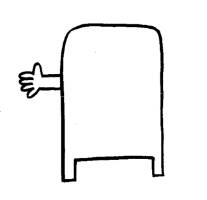Summary
In this lesson, students engage in three different learning explorations around Droodles, which were originally created as silly drawings by Roger Moore with witty captions. This lesson borrows from Moore's work to create an experience that promotes problem-solving, mathematical reasoning, and mathematical justification. Students will extend their learning by creating their own explorations for peers to solve. This lesson can be implemented in many different grade levels ranging from middle school through high school. This lesson includes optional modifications for distance learning. Resources for use in Google Classroom are included.
Essential Question(s)
How can students develop their problem solving, mathematical reasoning, and justification skills?
Snapshot
Engage
Droodles (easy engagement around creating a caption)
Explore
Droodle exploration.
Explain
Students share how they used mathematical reasoning for each exploration.
Extend
Students create their own Droodles.
Evaluate
What? So what? Now what?
Materials
Stockpile of Droodles
Engage
To begin this lessson, you will first need to print (and laminate if you wish) the Droodles from the book "Classic Droodles" by Rodger Price (1992). There is a handout attached to this lesson that has copies if you do not have access to the book. This Engage activity is completed in two rounds as described below.
Round 1:
Display the Droodles on a flat surface. Ask students to select a Droodle that "speaks to them."
Have students return to their desks and create a caption for their Droodle.
Ask students to share their captions at their tables and explain why they chose the Droodle.
Solicit several responses from the class. These are typically a great way to get students engaged in conversation, which will be helpful for the explorations later.
Round 2:
Ask students to identify mathematical constructs found within their Droodle. This might include shapes, angles, line segments, symmetries, or other things students find mathematically interesting.
Have students share at their tables what mathematics they see within their Droodle.
Solicit several responses from the class.
Explore
This exploration is designed to help students classify and justify reasoning in a systematic way. Ask students to work in pairs for this activity.
First, make sure each pair of students has at least a dozen, but preferably more, Droodles at their table.
Next, ask students to organize their Droodles into two categories. The organization criteria is up to them.
Ask pairs to form groups of four. If there is an odd number, ask three pairs to join together. Have one pair justify how they categorized their Droodles, and then switch. Afterward, ask students to find new partners.
With their new partners, ask students to categorize their Droodles into four categories. Again the organization criteria is up to them.
Repeat the process of having pairs form groups of four. Have one pair justify how they categorized their Droodles, and then switch. Afterward, ask students to again find new partners.
Finally, ask students to categorize their Droodles further into as many or as few groups as they wish. The criteria they use is up to them.
This time, ask groups to explain their reasoning to the whole class. To do this, ask the class to gather around one group, giving them their full attention. Then, move on to the next group.
Explain
The purpose of this section is to discuss the challenges students faced with categorizing their Droodles. Using the sentence stems below, ask students to reflect on their exploration:
1. One thing I found challenging about this activity was....
2. One thing I did really well was...
3. Sorting Droodles made me think...
4. I used mathematics to....
5. I was able to justify my categories because...
Extend
To create Droodles, distribute paper, a straightedge, a compass, and pencils to each student.
Ask students to fold their paper into four equal qudrants, like a window
Each quadrant will require students to incorporate different geometric shapes and patterns.
Top Left: Ask students to create a Droodle that incorporates at least one line of symmetry
Bottom Left: Ask students to create a Droodle that incorporates one square and one circle of equal area
Top Right: Ask students to create a Droodle with similar triangles
Bottom Right: Ask students to create an original Droodle that incorporates at least three geometric figures of their choice.
Evaluate
Use the What? So What? Now What? strategy to evaluate students' learning. Ask:
What did you do in your activity today?
How did you use mathematical reasoning when sorting Droodles?
How can this apply to other areas of mathematics?
Resources
K20 Center. (n.d.). What? So what? Now what?. Strategies. Retrieved from https://learn.k20center.ou.edu/strategy/b30762a7557ba0b391f207f4c6002113
Price, R. (1992). Classic Droodles. Los Angeles, CA: Price Stern Sloan.


